前言
最近查看了几位同事的代码,发现很多CSS编写习惯都是清一色的类而无相应的选择器,层层嵌套的标签都包含至少一个类。有些同学会问,很多文章都说选择器有性能问题,为何还需使用选择器呢?
是的,选择器和类对比起来性能上确实没后者那么好,但是如今浏览器对于CSS的解析速度已得到大大的提升,完全可忽略选择器那丁点的性能问题。有兴趣的同学可自行百度搜索CSS选择器性能的相关问题学习。多一个技巧多一份保障!
本章不细说选择器的性能问题,而是细说怎样用好选择器。先来对选择器做一个功能性的分类。当然熟悉全部CSS选择器是玩转CSS的最最最最最基本功。
分类
在讲解选择器的奇妙用处前,还是先把选择器分类记忆吧。没错,笔者就是喜欢总结。由于选择器的标准概念上无作出明确的分类,以下的分类是为了方便记忆而整理的。
基础选择器
| 选择器 | 别名 | 说明 | 版本 |
|---|---|---|---|
tag |
标签选择器 | 指定类型的标签 |
1 |
#id |
ID选择器 | 指定身份的标签 |
1 |
.class |
类选择器 | 指定类名的标签 |
1 |
* |
通配选择器 | 所有类型的标签 |
2 |
层次选择器
| 选择器 | 别名 | 说明 | 版本 |
|---|---|---|---|
elemP elemC |
后代选择器 |
元素的后代元素 |
1 |
elemP>elemC |
子代选择器 |
元素的子代元素 |
2 |
elem1+elem2 |
相邻同胞选择器 |
元素相邻的同胞元素 |
2 |
elem1~elem2 |
通用同胞选择器 |
元素后面的同胞元素 |
3 |
集合选择器
| 选择器 | 别名 | 说明 | 版本 |
|---|---|---|---|
elem1,elem2 |
并集选择器 |
多个指定的元素 |
1 |
elem.class |
交集选择器 |
指定类名的元素 |
1 |
条件选择器
| 选择器 | 说明 | 版本 |
|---|---|---|
:lang |
指定标记语言的元素 |
2 |
:dir() |
指定编写方向的元素 |
4 |
:has |
包含指定元素的元素 |
4 |
:is |
指定条件的元素 |
4 |
:not |
非指定条件的元素 |
4 |
:where |
指定条件的元素 |
4 |
:scope |
指定元素作为参考点 |
4 |
:any-link |
所有包含href的链接元素 |
4 |
:local-link |
所有包含href且属于绝对地址的链接元素 |
4 |
行为选择器
| 选择器 | 说明 | 版本 |
|---|---|---|
:active |
鼠标激活的元素 |
1 |
:hover |
鼠标悬浮的元素 |
1 |
::selection |
鼠标选中的元素 |
3 |
状态选择器
| 选择器 | 说明 | 版本 |
|---|---|---|
:target |
当前锚点的元素 |
3 |
:link |
未访问的链接元素 |
1 |
:visited |
已访问的链接元素 |
1 |
:focus |
输入聚焦的表单元素 |
2 |
:required |
输入必填的表单元素 |
3 |
:valid |
输入合法的表单元素 |
3 |
:invalid |
输入非法的表单元素 |
3 |
:in-range |
输入范围以内的表单元素 |
3 |
:out-of-range |
输入范围以外的表单元素 |
3 |
:checked |
选项选中的表单元素 |
3 |
:optional |
选项可选的表单元素 |
3 |
:enabled |
事件启用的表单元素 |
3 |
:disabled |
事件禁用的表单元素 |
3 |
:read-only |
只读的表单元素 |
3 |
:read-write |
可读可写的表单元素 |
3 |
:target-within |
内部锚点元素处于激活状态的元素 |
4 |
:focus-within |
内部表单元素处于聚焦状态的元素 |
4 |
:focus-visible |
输入聚焦的表单元素 |
4 |
:blank |
输入为空的表单元素 |
4 |
:user-invalid |
输入合法的表单元素 |
4 |
:indeterminate |
选项未定的表单元素 |
4 |
:placeholder-shown |
占位显示的表单元素 |
4 |
:current() |
浏览中的元素 |
4 |
:past() |
已浏览的元素 |
4 |
:future() |
未浏览的元素 |
4 |
:playing |
开始播放的媒体元素 |
4 |
:paused |
暂停播放的媒体元素 |
4 |
结构选择器
| 选择器 | 说明 | 版本 |
|---|---|---|
:root |
文档的根元素 |
3 |
:empty |
无子元素的元素 |
3 |
:first-letter |
元素的首字母 |
1 |
:first-line |
元素的首行 |
1 |
:nth-child(n) |
元素中指定顺序索引的元素 |
3 |
:nth-last-child(n) |
元素中指定逆序索引的元素 |
3 |
:first-child |
元素中为首的元素 |
2 |
:last-child |
元素中为尾的元素 |
3 |
:only-child |
父元素仅有该元素的元素 |
3 |
:nth-of-type(n) |
标签中指定顺序索引的标签 |
3 |
:nth-last-of-type(n) |
标签中指定逆序索引的标签 |
3 |
:first-of-type |
标签中为首的标签 |
3 |
:last-of-type |
标签中为尾标签 |
3 |
:only-of-type |
父元素仅有该标签的标签 |
3 |
属性选择器
| 选择器 | 说明 | 版本 | |
|---|---|---|---|
[attr] |
指定属性的元素 |
2 | |
[attr=val] |
属性等于指定值的元素 |
2 | |
[attr*=val] |
属性包含指定值的元素 |
3 | |
[attr^=val] |
属性以指定值开头的元素 |
3 | |
[attr$=val] |
属性以指定值结尾的元素 |
3 | |
[attr~=val] |
属性包含指定值(完整单词)的元素(不推荐使用) |
2 | |
| `[attr | =val]` | 属性以指定值(完整单词)开头的元素(不推荐使用) |
2 |
伪元素
| 选择器 | 说明 | 版本 |
|---|---|---|
::before |
在元素前插入的内容 | 2 |
::after |
在元素后插入的内容 | 2 |
优势
话说选择器若无用处,那W3C还干嘛把它纳入到标准里呢?选择器的劣势就不啰嗦了,使用不当可能会引起解析性能问题,这个对于现代浏览器来说几乎可忽略,除非你还是IExplorer的忠实粉丝。使用选择器有什么好处呢?笔者给各位同学总结一下。
- 对于那些结构与行为分离的写法,使用
sass/less编写属性时结构会更清晰易读 - 减少很多无用或少用的类,保持
css文件的整洁性和观赏性,代码也是一门艺术 - 减少修改类而有可能导致样式失效的问题,有时修改类但无确保HTML中和CSS中的一致而导致样式失效
- 减少无实质性使用的类,例如很多层嵌套的标签,这些标签可能只使用到一个CSS属性,就没必要建个类关联
- 使用选择器可实现一些看似只能由JS才能实现的效果,既可减少代码量也可减少JS对DOM的操作,使得交互效果更流畅
场景
由于选择器太多,笔者选择几个最具代表性的耍耍,通过选择器的妙用实现一些看似只能由JS才能实现的效果。未提到的选择器可能在其他地方穿插着讲解,请各位同学放心学习。+和~
+/~都是作用于当前节点后的同胞节点,但是两者有一个明显的区别,+是针对紧随该节点的节点,而~是针对后面所有的节点,包括紧随该节点的节点。~还可针对一些特定类和选择器的节点,所以其使用性更广泛。
另外,+/~通常都会结合:checked完成一些高难度的纯CSS效果,当<input>触发了:checked选中状态后可通过+/~带动后面指定的节点声明一些特别属性。
通常其CSS代码形式如下。input:checked + div {}input:checked ~ div {}
+/~的用途很广,静态效果和动态效果都能用上它,是两个很关键的选择器。以下通过动静结合的方式展示+/~的用途。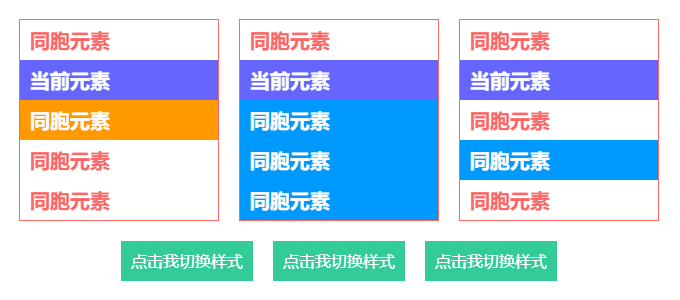
<div class="specify-selector"> <ul class="list"> <li>同胞元素</li> <li class="next">当前元素</li> <li>同胞元素</li> <li>同胞元素</li> <li>同胞元素</li> </ul> <ul class="list"> <li>同胞元素</li> <li class="next-all">当前元素</li> <li>同胞元素</li> <li>同胞元素</li> <li>同胞元素</li> </ul> <ul class="list"> <li>同胞元素</li> <li class="next-filter">当前元素</li> <li>同胞元素</li> <li class="filter">同胞元素</li> <li>同胞元素</li> </ul> </div> <div class="specify-selector"> <div class="button"> <input id="btn1" type="radio" name="btns" hidden> <label for="btn1">点击我切换样式</label> </div> <div class="button"> <input id="btn2" type="radio" name="btns" hidden> <label for="btn2">点击我切换样式</label> </div> <div class="button"> <input id="btn3" type="radio" name="btns" hidden> <label for="btn3">点击我切换样式</label> </div> </div>.specify-selector { display: flex; & + .specify-selector { margin-top: 20px; } .list { border: 1px solid #f66; width: 200px; line-height: 2; font-weight: bold; font-size: 20px; color: #f66; & + .list { margin-left: 20px; } li { padding: 0 10px; } .next { background-color: #66f; color: #fff; & + li { background-color: #f90; color: #fff; } } .next-all { background-color: #66f; color: #fff; & ~ li { background-color: #09f; color: #fff; } } .next-filter { background-color: #66f; color: #fff; & ~ .filter { background-color: #09f; color: #fff; } } } .button { & + .button { margin-left: 20px; } label { display: block; padding: 0 10px; height: 40px; background-color: #3c9; cursor: pointer; line-height: 40px; font-size: 16px; color: #fff; transition: all 300ms; } input:checked + label { padding: 0 20px; border-radius: 20px; background-color: #f66; } } }
- 在线演示:Here
在线源码:Here
:hover
:hover作用于鼠标悬浮的节点,是一个很好用的选择器。在特定场景可代替mouseenter和mouseleave两个鼠标事件,加上transtion让节点的动画更丝滑。
结合attr()有一个很好用的场景,就是鼠标悬浮在某个节点上显示提示浮层,提示浮层里包含着该动作的文本。给节点标记一个用户属性
data-*- 当鼠标悬浮在该节点上触发
:hover - 通过
attr()获取data-*的内容 - 将
data-*的内容赋值到伪元素的content上
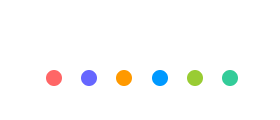
<ul class="hover-tips">
<li data-name="姨妈红"></li>
<li data-name="基佬紫"></li>
<li data-name="箩底橙"></li>
<li data-name="姣婆蓝"></li>
<li data-name="大粪青"></li>
<li data-name="原谅绿"></li>
</ul>
$color-list: #f66 #66f #f90 #09f #9c3 #3c9;
.hover-tips {
display: flex;
justify-content: space-between;
width: 200px;
li {
position: relative;
padding: 2px;
border: 2px solid transparent;
border-radius: 100%;
width: 24px;
height: 24px;
background-clip: content-box;
cursor: pointer;
transition: all 300ms;
&::before,
&::after {
position: absolute;
left: 50%;
bottom: 100%;
opacity: 0;
transform: translate3d(0, -30px, 0);
transition: all 300ms;
}
&::before {
margin: 0 0 12px -35px;
border-radius: 5px;
width: 70px;
height: 30px;
background-color: rgba(#000, .5);
line-height: 30px;
text-align: center;
color: #fff;
content: attr(data-name);
}
&::after {
margin-left: -6px;
border: 6px solid transparent;
border-top-color: rgba(#000, .5);
width: 0;
height: 0;
content: "";
}
@each $color in $color-list {
$index: index($color-list, $color);
&:nth-child(#{$index}) {
background-color: $color;
&:hover {
border-color: $color;
}
}
}
&:hover {
&::before,
&::after {
opacity: 1;
transform: translate3d(0, 0, 0);
}
}
}
}
- 在线演示:Here
在线源码:Here
:valid和:invalid
很多同学可能还会使用JS去判断表单输入内容是否合法,其实HTML5发布后,可用纯CSS完成这些工作,正确搭配一些属性能大大减少校验表单的代码量。
完成一个完整的表单验证,需以下HTML属性和选择器搭配。placeholder:占位,在未输入内容时显示提示文本
- pattern:正则,在输入内容时触发正则验证
- :valid:作用于输入合法的表单节点
- :invalid:作用于输入非法的表单节点
<input type="text" placeholder="" pattern="">
这个input:valid {} input:invalid {}pattern与JS正则有点不同,JS的正则形式是/regexp/,而pattern的正则形式只需/regexp/里的regexp。这个校验过程是动态触发的,监听了input这个键盘事件,当输入内容合法时触发:valid,当输入内容非法时触发:invalid。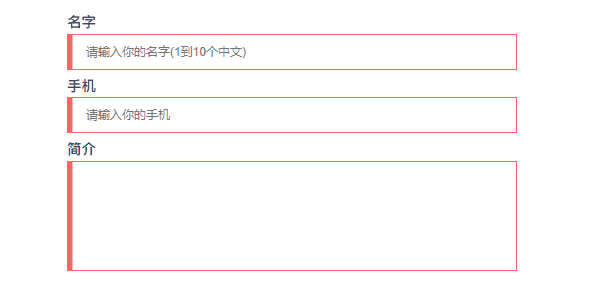
<form class="form-validation"> <div> <label>名字</label> <input type="text" placeholder="请输入你的名字(1到10个中文)" pattern="^[\u4e00-\u9fa5]{1,10}$" required> </div> <div> <label>手机</label> <input type="text" placeholder="请输入你的手机" pattern="^1[3456789]\d{9}$" required> </div> <div> <label>简介</label> <textarea required></textarea> </div> </form>.form-validation { width: 500px; div + div { margin-top: 10px; } label { display: block; padding-bottom: 5px; font-weight: bold; font-size: 16px; } input, textarea { display: block; padding: 0 20px; border: 1px solid #ccc; width: 100%; height: 40px; outline: none; caret-color: #09f; transition: all 300ms; &:valid { border-color: #3c9; } &:invalid { border-color: #f66; } } textarea { height: 122px; resize: none; line-height: 30px; font-size: 16px; } }
- 在线演示:Here
- 在线源码:Here
:checked
:checked作用于选项选中的表单节点,当<input>的type设置成radio和checkbox时可用。在CSS神操作骚技巧中是一个很重要的技巧,主要是用于模拟鼠标点击事件。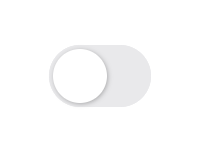
<input class="ios-switch" type="checkbox">.btn { border-radius: 31px; width: 102px; height: 62px; background-color: #e9e9eb; } .ios-switch { position: relative; appearance: none; cursor: pointer; transition: all 100ms; @extend .btn; &::before { position: absolute; content: ""; transition: all 300ms cubic-bezier(.45, 1, .4, 1); @extend .btn; } &::after { position: absolute; left: 4px; top: 4px; border-radius: 27px; width: 54px; height: 54px; background-color: #fff; box-shadow: 1px 1px 5px rgba(#000, .3); content: ""; transition: all 300ms cubic-bezier(.4, .4, .25, 1.35); } &:checked { background-color: #5eb662; &::before { transform: scale(0); } &::after { transform: translateX(40px); } } }
上述有提到与+/~的搭配使用,在此还有一个很重要的技巧,就是结合<label>使用。为何要结合<label>呢?因为要让input:checked + div {}或input:checked ~ div {}起效,其HTML结构必须像以下那样。
<input type="radio">
<div></div>
这样就无法分离结构与行为了,导致CSS必须跟着HTML走,只能使用绝对定位将<input>固定到指定位置。使用<label>绑定<input>,可将<input>的鼠标选择事件转移到<label>上,由<label>控制选中状态。那么HTML结构可改为以下那样,此时的<input>可设置hidden隐藏起来,不参与任何排版。
<input type="radio" id="btn" hidden>
<div>
<label for="btn">
</div>
<input>使用id与<label>使用for关联起来,而hidden使<input>隐藏起来,不占用页面任何位置,此时<label>放置在页面任何位置都行。
input:checked + div {}
input:checked ~ div {}
笔者使用纯CSS实现的标签导航是一个很好的学习用例,在第8章变量计算有提及。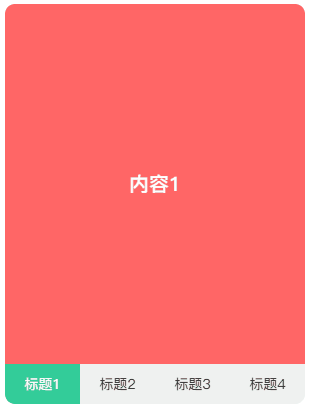
- 在线演示:Here
- 在线源码:Here
:focus-within
:focus-within作用于内部表单节点处于聚焦状态的节点。它监听当前节点里是否有表单节点,且该表单节点是否处于聚焦状态。
有些同学听上去可能觉得拗口,其实它是一个简单易用的属性。表单控件触发focus和blur两个鼠标事件后往祖先节点冒泡,在祖先节点上通过:focus-within捕获该冒泡事件声明样式。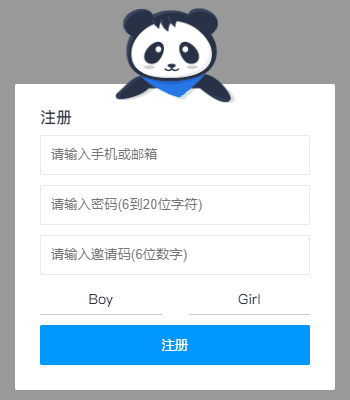
<form class="bubble-distribution"> <h3>注册</h3> <div class="accout"> <input type="text" placeholder="请输入手机或邮箱" pattern="^1[3456789]\d{9}$|^[\w-]+(\.[\w-]+)*@[\w-]+(\.[\w-]+)+$" required> <img src="https://b-gold-cdn.xitu.io/v3/static/img/greeting.1415c1c.png"> </div> <div class="password"> <input type="password" placeholder="请输入密码(6到20位字符)" pattern="^[\dA-Za-z_]{6,20}$" required> <img src="https://b-gold-cdn.xitu.io/v3/static/img/blindfold.58ce423.png"> </div> <div class="code"> <input type="text" placeholder="请输入邀请码(6位数字)" pattern="^[\d]{6}$" maxLength="6" required> <button type="button">查询</button> <img src="https://b-gold-cdn.xitu.io/v3/static/img/greeting.1415c1c.png"> </div> <img src="https://b-gold-cdn.xitu.io/v3/static/img/normal.0447fe9.png"> <ul> <li> <input id="male" type="radio" name="sex"> <label for="male">Boy</label> </li> <li> <input id="female" type="radio" name="sex"> <label for="female">Girl</label> </li> </ul> <button type="button">注册</button> </form>.bubble-distribution { position: relative; margin-top: 50px; padding: 25px; border-radius: 2px; width: 320px; background-color: #fff; h3 { font-size: 16px; color: #333; } div { margin-top: 10px; } img { position: absolute; left: 50%; bottom: 100%; margin: 0 0 -20px -60px; width: 120px; } ul { display: flex; justify-content: space-between; align-items: center; margin-top: 10px; height: 30px; line-height: 30px; } li { position: relative; width: 45%; transition: all 300ms; &:focus-within { background: linear-gradient(90deg, #09f 50%, transparent 0) repeat-x, linear-gradient(90deg, #09f 50%, transparent 0) repeat-x, linear-gradient(0deg, #09f 50%, transparent 0) repeat-y, linear-gradient(0deg, #09f 50%, transparent 0) repeat-y; background-position: 0 0, 0 100%, 0 0, 100% 0; background-size: 8px 1px, 8px 1px, 1px 8px, 1px 8px; animation: move 500ms infinite linear; } } input[type=text], input[type=password] { padding: 10px; border: 1px solid #e9e9e9; border-radius: 2px; width: 100%; height: 40px; outline: none; transition: all 300ms; &:focus:valid { border-color: #09f; } &:focus:invalid { border-color: #f66; } } input[type=radio] { position: absolute; width: 0; height: 0; &:checked + label { border: 3px solid transparent; background-color: #09f; color: #fff; } } label { display: block; border-bottom: 1px solid #ccc; width: 100%; background-clip: padding-box; cursor: pointer; text-align: center; transition: all 300ms; } button { overflow: hidden; margin-top: 10px; border: none; border-radius: 2px; width: 100%; height: 40px; outline: none; background-color: #09f; cursor: pointer; color: #fff; transition: all 300ms; } .accout, .password, .code { img { display: none; margin-bottom: -27px; } &:focus-within { img { display: block; } & ~ img { display: none; } } } .code { display: flex; justify-content: space-between; button { margin-top: 0; } input { &:not(:placeholder-shown) { width: 70%; & + button { width: 25%; } } &:placeholder-shown { width: 100%; & + button { width: 0; opacity: 0; } } } } } @keyframes move { to { background-position: 6% 0, -6% 100%, 0 -6%, 100% 6%; } }
- 在线演示:Here
在线源码:Here
:empty
还有使用JS判断列表集合为空时显示占位符吗?相信很多使用MVVM框架开发的同学都会使用条件判断的方式渲染虚拟DOM,若列表长度不为0则渲染列表,否则渲染占位符。然而CSS提供了一个空判断的选择器
:empty,这应该很少同学会注意到。:empty作用于无子节点的节点,这个子节点也包括行内匿名盒(单独的文本内容),匿名盒在第4章盒模型有提及。以下三种情况均为非空状态,若不出现这三种状态则为空状态,此时:empty才会触发。仅存在节点:
<div><p>CSS</p></div>- 仅存在文本:
<div>CSS</div> - 同时存在节点和文本:
<div>Hello <p>CSS</p></div>
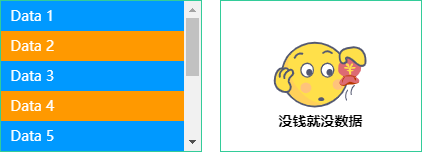
<ul class="empty-list">
<li v-for="v in 10" :key="v">Data {{v}}</li>
</ul>
<ul class="empty-list"></ul>
$empty: "https://yangzw.vip/img/empty.svg";
.empty-list {
overflow: auto;
width: 200px;
height: 150px;
outline: 1px solid #3c9;
&:empty {
display: flex;
justify-content: center;
align-items: center;
background: url($empty) no-repeat center/100px auto;
&::after {
margin-top: 90px;
font-weight: bold;
content: "没钱就没数据";
}
}
& + .empty-list {
margin-left: 20px;
}
li {
padding: 0 10px;
height: 30px;
background-color: #09f;
line-height: 30px;
color: #fff;
&:nth-child(even) {
background-color: #f90;
}
}
}
- 在线演示:Here
在线源码:Here
::before和::after
有时为了实现某个效果而往页面里反复添加标签变得很繁琐,添加太多标签反而不好处理而变得难以维护。此时会引入
伪元素这个概念解决上述问题。
伪元素指页面里不存在的元素。伪元素在HTML代码里未声明,却能正常显示,在页面渲染时看到这些本来不存在的元素发挥着重要作用。:before和:after是两个很重要的伪元素,早在CSS2就出现了。
起初伪元素的前缀使用单冒号语法。随着CSS改革,伪元素的前缀被修改成双冒号语法,:before/:after从此变成::before/::after,用来区分伪类。若兼容低版本浏览器,还需使用:before和:after,但是本小册均以::before/::after编写CSS代码。伪元素和伪类虽然都是选择器,但是它们还是存在一丝丝的差别。伪元素通常是一些实体选择器,选择满足指定条件的DOM,例如::selection、:nth-child(n)和:first-child伪类通常是一些状态选择器,选择处于特定状态的DOM,例如:hover、:focus和:checked
::before/::after必须结合content使用,通常用作修饰节点,为节点插入一些多余的东西,但又不想内嵌一些其他标签。若插入2个以下(包含2个)的修饰,建议使用::before/::after。
以下两个HTML结构是等效的
<p>
<span>:before</span>
CSS
<span>:after</span>
</p>
<p>CSS</p>
// 接上一个HTML结构
p {
&::before {
content: ":before";
}
&::after {
content: ":after";
}
}
::before/::after最常用的场景就是气泡对话框,圆滚滚的身子带上一个三角形的尾巴。像以下第二个挖空的气泡对话框,其实使用白色填充背景颜色,而小尾巴使用白色的::after叠加橙色的::before形成障眼法。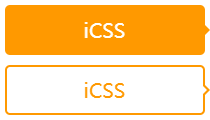
<div class="bubble-box">iCSS</div>
<div class="bubble-empty-box">iCSS</div>
.bubble-box {
position: relative;
border-radius: 5px;
width: 200px;
height: 50px;
background-color: #f90;
line-height: 50px;
text-align: center;
font-size: 20px;
color: #fff;
&::after {
position: absolute;
left: 100%;
top: 50%;
margin-top: -5px;
border: 5px solid transparent;
border-left-color: #f90;
content: "";
}
}
.bubble-empty-box {
position: relative;
margin-top: 10px;
border: 2px solid #f90;
border-radius: 5px;
width: 200px;
height: 50px;
line-height: 46px;
text-align: center;
font-size: 20px;
color: #f90;
&::before {
position: absolute;
left: 100%;
top: 50%;
margin: -5px 0 0 2px;
border: 5px solid transparent;
border-left-color: #f90;
content: "";
}
&::after {
position: absolute;
left: 100%;
top: 50%;
margin-top: -4px;
border: 4px solid transparent;
border-left-color: #fff;
content: "";
}
}

